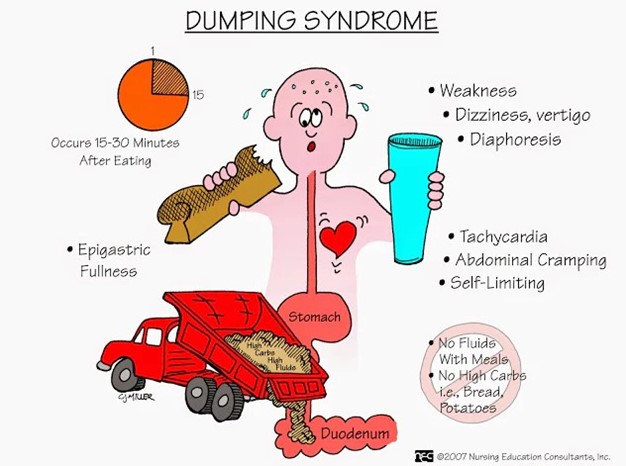In order to prevent dumping syndrome after Gastric Bypass surgery, the nurse will instruct the client to....
Take a brisk walk after eating.
Avoid excessive sugar and carbohydrates.
Increase fluid intake with meals.
Take the proton pump inhibitors as prescribed.
The Correct Answer is B
Dumping syndrome is a common complication after Gastric Bypass surgery, where food moves too quickly from the stomach to the small intestine. It occurs when the undigested contents of the stomach are "dumped" rapidly into the small intestine, leading to symptoms such as nausea, vomiting, abdominal cramps, diarrhea, lightheadedness, and sweating.
To manage dumping syndrome, it is important for the client to avoid foods and beverages that are high in sugar and carbohydrates. Consuming these types of foods can trigger rapid gastric emptying and exacerbate the symptoms. Instead, the client should focus on a well-balanced diet that includes lean proteins, healthy fats, and complex carbohydrates.

Nursing Test Bank
Naxlex Comprehensive Predictor Exams
Related Questions
Correct Answer is C
Explanation
Morphine is a potent opioid analgesic that can depress the respiratory system. Respiratory depression is a potential adverse effect of morphine, and it is essential for the nurse to monitor the patient's respiratory rate regularly to ensure adequate oxygenation and prevent respiratory complications.
By checking the respiratory rate, the nurse can assess if the patient is breathing adequately and detect any signs of respiratory depression. If the respiratory rate is significantly decreased or the patient shows signs of respiratory distress (e.g., shallow or irregular breathing), immediate intervention is necessary to address the situation promptly.
Correct Answer is B
Explanation
A paralytic ileus is a type of bowel obstruction characterized by the impairment or absence of normal bowel motility. It occurs due to the temporary paralysis or dysfunction of the muscles that propel food and waste material through the intestines. After surgery, paralytic ileus can occur as a result of the handling of the intestines during the procedure, the effects of anesthesia, or the body's response to inflammation and trauma.
The absence of bowel sounds is a key indicator of paralytic ileus. Normally, bowel sounds are present and indicate the movement of contents through the intestines. However, in a paralytic ileus, the bowel sounds may be diminished or absent due to the lack of peristalsis (wave-like contractions that move food along the digestive tract).
Whether you are a student looking to ace your exams or a practicing nurse seeking to enhance your expertise , our nursing education contents will empower you with the confidence and competence to make a difference in the lives of patients and become a respected leader in the healthcare field.
Visit Naxlex, invest in your future and unlock endless possibilities with our unparalleled nursing education contents today
Report Wrong Answer on the Current Question
Do you disagree with the answer? If yes, what is your expected answer? Explain.
Kindly be descriptive with the issue you are facing.
